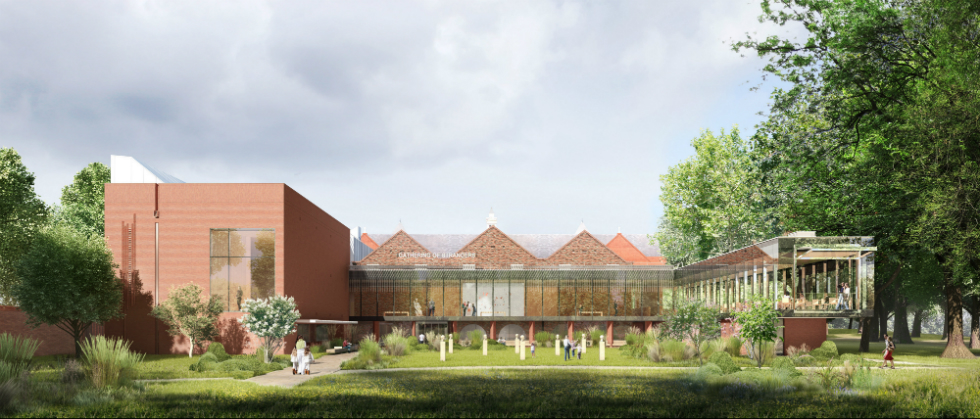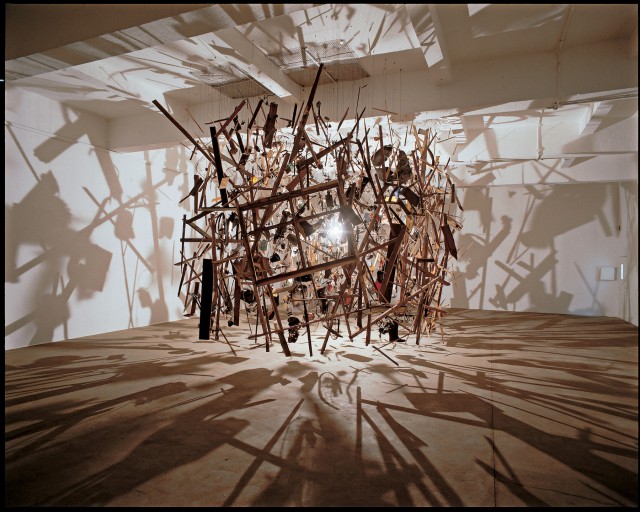“A Kind Of Magic”: Maria Balshaw On The New Whitworth

Ahead of the gallery’s grand reopening in February 2015, The Whitworth director Maria Balshaw speaks to Nichola Jacques about the multi-million pound makeover, secret refurbishment discoveries, and exploding things with Cornelia Parker…
The Whitworth Art Gallery is currently enjoying a significant and exciting £15m renovation. Eager to know what the new space will be like — will it be transformed beyond recognition? What artists will exhibit at the launch? — I was lucky enough to pin down its incredibly busy director, Maria Balshaw.
Balshaw is joint-director of both The Whitworth – part of the University of Manchester – and Manchester Art Gallery, and is responsible for the artistic and strategic vision for each (as well as over 80,000 fine and decorative art objects in their historic collections). She is also Strategic Lead for Culture for Manchester City Council and a new board member of Arts Council England.
As we sit amidst the chaotic flux of uprooted staff and skilfully packed storage boxes at the gallery’s temporary home on Dover Street, I’m keen to hear everything about the new building. The Whitworth’s website states that the new rooms will ‘redefine [the gallery’s] role for the 21st Century’. How fair is it to say that the extension into the surrounding gardens in fact marks a return to the original – Victorian – ethos of the building and the institution?
“There are two things happening simultaneously with the gallery,” she begins. “One is that we’re creating two new wings at the back of the original gallery that extend out into the park, give us a third more physical space and create an outdoor gallery, an ‘art garden.’ But at the same time as [creating] the new building, we’re also renovating the old building. It will take advantage of the really gracious classical form of those original gallery spaces that had been disrupted during the 20th Century.”
Balshaw confirms that barrelled ceilings, roof lights, wooden beams and plasterwork have all been masterfully restored. Cutting-edge equipment will permit the control of air flow and lighting. Enormous floor and ceiling loadings will enable the gallery to comfortably house large-scale pieces, “whether that is a huge Richard Long installation or a massive piece of Richard Serra steel.” Balshaw goes on to explain what will be unveiled to the public: “the 1908 spaces, just like they looked in the 1908 photographs, but created using 21st Century technology”.
There has also been an astonishing discovery behind a run of windows visible from the Oxford Road entrance on the second storey of the building, set back from the flat roof of the entrance. Over the past 50 years this space has been carved up into a library, a print room, staff offices, and textile storage. Hidden above a false ceiling – “fantastic, crap false ceiling. Terrible. One of those foam tiled ones” – was a series of hammer beam struts, and “hidden behind bookshelves and plasterboard walls was beautifully ornate wood panelling, almost up to head height”.
In copperplate writing, the 1908 plans for the Whitworth denote this space as the ‘Grand Hall’ complete with ‘Pantry’ next door. “This will be a remarkable discovery for everyone that knows the Whitworth well,” says Balshaw. “It’s going to be like one of those magic tricks. People will ask, ‘where did they get this place from? How can it be here when it wasn’t here before?’”
Following the renovation, the Whitworth’s Grand Hall will once again house lectures, talks, dinners, recitals, orchestras in residence. “It was always meant to be a space for people”, remarks Balshaw.
Whilst the rediscovery of original features is an important aspect of the gallery’s renovation, so too is the creation of two new wings which will envelop the beauty of the outdoors in a more literal sense than ever before. “We think that’s our future, really embracing the whole park. But it also comes from the history of the gallery.” Reconnecting to the ethos of the gallery’s founders is, according to Balshaw, a central tenet. “The original intention of the founders of the gallery was to make a gallery in the park. The early committee reports talk about people of all social classes coming and enjoying a Sunday walk in the park and enjoying the boating lake and the pleasure gardens and promenading and then enjoying the art inside.”
Returning from a trip to Oslo in 1932, Margaret Pilkington, the only other female director in the Whitworth’s history, said she “had come to the conclusion that a good museum or gallery was a place where people feel comfortable… If it stands in a garden or park, one should be able to contemplate the beauty of the outdoors as a counterpoint to the beauty within’’.

In a lovely echo of this statement, Balshaw describes how an enormous tree, planted as a sapling on the centre line of the Whitworth by the founders of the gallery, will be framed by an opening within the new Whitworth: “From the very heart of the building you’ll be able to look out and see the park.”
Juxtaposing curiously against this backdrop of restoration and building works, the Whitworth’s opening programme features two artists, Cornelia Parker (above) and Cai Guo-Qiang, who share an interest in exploding things. “Parker is very interested in the transformation of matter and Cai is interested in what happens through the process of explosion” says Balshaw, who was determined that Parker be persuaded to do the opening solo show, an invitation which the artist eagerly accepted.
“[Parker] actively seeks out other kinds of experts – non-artists – to work and collaborate with. She realises her ideas and concepts through dialogue with people: academics, scientists, medics, archaeologists, people who are as different to her as it’s possible to imagine and so I knew that we had something to offer her.”
Taking advantage of the Whitworth’s unique position within the University of Manchester, Balshaw introduced Parker to Kostya Novoselov, the Nobel prize-winning inventor of graphene. The culmination of this exceptional collaborative project will be revealed at the end of the gallery’s opening night.
Alongside this, Cai Guo-Qiang’s Unmanned Nature — a series of gunpowder drawings — will run across all the walls of the Landscape gallery surrounding a pool of water. This work, for Balshaw, “is about peace and reconciliation as well as the impact of conflict. It feels like a really appropriate piece to be having almost at the end of the first year marking 100 years since the outbreak of WW1.”
Had the Whitworth re-opened earlier in 2014, The Sensory War exhibition, which opened at Manchester Art Gallery earlier this month, would have been shared across the two sites of Balshaw’s directorship. However, Balshaw identifies Cai Guo-Qiang’s piece as a “coda” to The Sensory War show.
Following on from We Face Forward, a multi-site presentation of contemporary art from West Africa that Balshaw led on in 2012, she is currently planning an ambitious project that will explore the image of Islam, “from the earliest representations that we have in [the collections of Manchester Art Gallery and the Whitworth] right through to contemporary artists [utilising] every medium that we can”. The project, which may also involve Manchester Museum, HOME and quite possibly other galleries in the city, is planned for 2016.
Alongside city-wide projects, Balshaw has also spent the last two years pursuing relationships with galleries and colleagues in Hong Kong. It has been agreed that an incredibly important collection of contemporary Chinese art – the Sigg collection – will be shown at the Whitworth before it moves to its new, permanent home at M+ in the West Kowloon Cultural District of Hong Kong. The collection has been shown only once in Umea, Sweden. Once it arrives at its new proposed home – a gallery three times the size of Tate Modern which will open around 2018 – it may never return to Europe.
“It will really feel like a ‘see it now or don’t see it at all’ show. I really hope it will be the beginning of a long-term relationship with M+”, enthuses Balshaw.
Details of the Manchester International Festival (MIF15) programme are embargoed until the programme is launched in February; however, Balshaw was able to reveal a tantalising list of exciting artists – Sarah Lucas, Bedwyr Williams, Richard Foster, Nico Vascellari – whose work will feature at the Whitworth.
When asked whether there are any artists who Balshaw has always wanted to work with but has not yet had the chance, she replied: “Well there were some but they’re coming!” and then continued: “What I like most, what we all like most, curatorially, is to work with artists who respond to what the Whitworth is.
“What I enjoy the most is rarely those artists who I might personally like the most, but it’s those artists who are most interested in what we can offer them. So, like Cornelia Parker, artists who want our context or what a connection to our collection. And you sometimes don’t know that until the artist comes to visit.”
Balshaw recalls how Nikhil Chopra, whose performance work Coal on Cotton was part of MIF13, fell head over heels in love with the Whitworth’s historic collection. “The series of projects that we’ve done with him since came out of a really passionate and emotional and intellectual connection to the thing that the Whitworth is, and you don’t know that when you first meet an artist.”
Throughout my discussion with Balshaw, it became clear that both The Whitworth and Manchester Art Gallery – under her dual directorship – actively invite artists to acquaint themselves with the respective organisations and their collections, “so that artists can make the best work for the city and the galleries that we are,” she concludes.
“They tend to be the exhibitions that have a kind of magic about them.”
Nichola Jacques





